 W
WAconophora compressa is a species of insect in the treehopper family, Membracidae. It is known by the common names lantana bug, lantana treehopper, lantana stemsucking treehopper, and lantana sap-sucking bug.
 W
WAgapeta zoegana is a species of moth known as the sulphur knapweed moth and the yellow-winged knapweed root moth. It is used as an agent of biological pest control against noxious knapweeds, particularly spotted knapweed and diffuse knapweed.
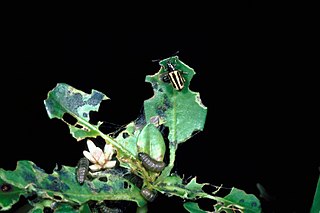 W
WAgasicles hygrophila is a species of leaf beetle known by the common name alligator weed flea beetle. It has been used successfully as an agent of biological pest control against the noxious aquatic plant known as alligator weed.
 W
WAgrilus hyperici, the St. John's wort root borer, is a species of jewel beetle. It is used as an agent of biological pest control against common St. John's wort in areas where it is a noxious weed or invasive species.
 W
WArcola malloi is a species of snout moth known as the alligator weed stem borer. It is used as an agent of biological pest control against the noxious aquatic plant known as alligator weed.
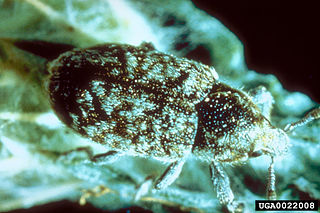 W
WBangasternus fausti is a species of true weevil known as the broad-nosed seed head weevil. It is used as an agent of biological pest control against noxious knapweeds, particularly spotted knapweed, squarrose knapweed, and diffuse knapweed.
 W
WBruchidius villosus is a species of bean weevil known by the common names broom seed beetle and Scotch broom bruchid. This beetle is used as an agent of biological pest control against the noxious weed known as Scotch broom.
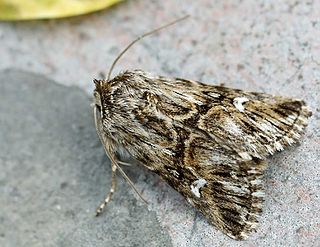 W
WCalophasia lunula is a Palearctic species of noctuid moth known by the common names toadflax moth and toadflax brocade moth.
 W
WCibdela janthina is a sawfly of the family Tenthredinidae. This species originates from Sumatra in South-East Asia but had also been introduced to La Réunion in 2007 for biological pest control of Rubus alceifolius, a Rosaceae species that had become an invasive species.
 W
WCyphocleonus achates is a species of true weevil known as the knapweed root weevil. It is native to southern Europe and the Mediterranean and is used as an agent of biological pest control against noxious knapweeds, especially spotted knapweed. It has recently been spotted in India.
 W
WCyrtobagous salviniae is a species of weevil known as the salvinia weevil. It is used as an agent of biological pest control against the noxious aquatic plant giant salvinia.
 W
WDiorhabda carinata is a species of leaf beetle known as the larger tamarisk beetle which feeds on tamarisk trees from Ukraine, eastern Turkey and Syria east to northwest China, Kyrgyzstan and Pakistan, extending as far south as southern Iran. It is used in North America as a biological pest control agent against saltcedar or tamarisk, an invasive species in arid and semi-arid ecosystems.
 W
WDiorhabda carinulata is a species of leaf beetle known as the northern tamarisk beetle, which feeds on tamarisk trees from southern Russia and Iran to Mongolia and western China. This beetle is used in North America as a biological pest control agent against saltcedar or tamarisk, an invasive species in arid and semiarid ecosystems.
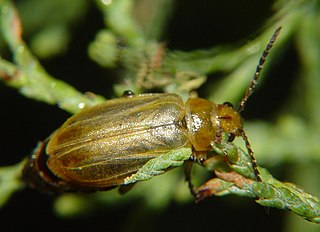 W
WDiorhabda elongata is a species of leaf beetle known as the Mediterranean tamarisk beetle (MTB) which feeds on tamarisk trees from Portugal and Algeria east to southern Russia. The MTB is used in North America as a biological pest control agent against saltcedar or tamarisk, an invasive species in arid and semi-arid ecosystems.
 W
WDiorhabda meridionalis is a species of leaf beetle known as the southern tamarisk beetle (SoTB) which feeds on tamarisk trees from Syria to western and southern Iran and southern Pakistan. The SoTB may have potential for use in North America as a biological pest control agent against saltcedar or tamarisk, an invasive species in arid and semi-arid ecosystems.
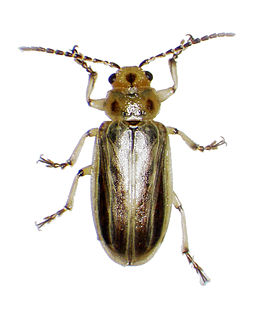 W
WDiorhabda sublineata is a leaf beetle known as the subtropical tamarisk beetle (STB). The species was first described by Hippolyte Lucas in 1849. It feeds on tamarisk trees from Portugal, Spain and France to Morocco, Senegal, Algeria, Tunisia, Egypt, Yemen, and Iraq. It is used in North America as a biological pest control agent against saltcedar or tamarisk, an invasive species in arid and semi-arid ecosystems.
 W
WEustenopus villosus is a species of true weevil known as the yellow starthistle hairy weevil. It is used as an agent of biological pest control against the noxious weed yellow starthistle.
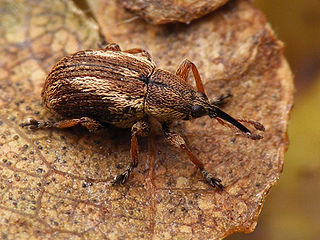 W
WExapion fuscirostre is a species of straight-snouted weevil known by the general common name Scotch broom seed weevil. It is used as an agent of biological pest control against the noxious weed known as Scotch broom.
 W
WExapion ulicis is a species of straight-snouted weevil known by the general common name Gorse Seed Weevil. It is used as an agent of biological pest control against Common Gorse, which is classified as a noxious weed in some countries.
 W
WGalerucella calmariensis is a species of leaf beetle in the family Chrysomelidae. It is commonly known as the black-margined loosestrife beetle and is native to Europe and Asia where both adults and larvae feed on purple loosestrife. It has been introduced in North America as a biological control agent for purple loosestrife.
 W
WGaltara extensa is a moth of the subfamily Arctiinae first described by Arthur Gardiner Butler in 1880. It is found on the Comoros and in Madagascar.
 W
WGratiana boliviana is a species of beetle in the leaf beetle family, Chrysomelidae. Its common name is tropical soda apple leaf beetle. It is native to South America, where its distribution includes Argentina, Brazil, and Paraguay. It specializes on tropical soda apple, an invasive plant species. It has been released as an agent of biological pest control against the weedy plant in Florida and other parts of the United States.
 W
WHydrellia pakistanae is a species of fly in the shore fly family, Ephydridae. It is known as the Asian hydrilla leaf-mining fly. It is used as an agent of biological pest control against the noxious aquatic plant hydrilla.
 W
WHyles euphorbiae, the spurge hawk-moth, is a European moth of the family Sphingidae. This hawk moth is used as an agent of biological pest control against the noxious weed leafy spurge, but usually only in conjunction with other agents. The larvae consume the leaves and bracts of the plant. The species was first described by Carl Linnaeus in his 1758 10th edition of Systema Naturae.
 W
WHylobius transversovittatus is a species of weevil in the family Curculionidae. It is native to the Old World where both adults and larvae feed on purple loosestrife. This plant is regarded as an invasive species in North America and the weevil has been introduced into both the United States and Canada in an effort to control the plant.
 W
WLarinus curtus is a species of true weevil known as the yellow starthistle flower weevil. It is native to Southern Italy, Southern Europe, the Middle East and the Caucasuses. It is used as an agent of biological pest control against the noxious weed yellow starthistle in the United States.
 W
WLarinus latus is a species of true weevil. It is used as an agent of biological pest control against Onopordum thistles in Australia.
 W
WLarinus obtusus is a species of true weevil known as the blunt knapweed flower weevil. It is used as an agent of biological pest control against noxious knapweeds, especially spotted knapweed.
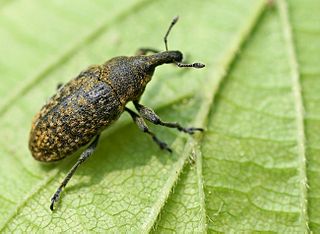 W
WLarinus planus is an insect of the Curculionidae family. They are oval shaped, dark brown or black, and about 5–10 millimetres long. While native to Europe, it is also common in North America. It feeds on floral buds, primarily of thistles, with the larvae stage being the most destructive to them. In North America, it has been used as a biocontrol agent. It is also known as Larinus carlinae.
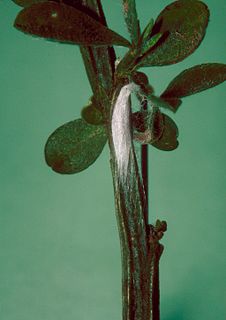 W
WLeucoptera spartifoliella is a species of moth in family Lyonetiidae known by the common name Scotch broom twig miner. It is used as an agent of biological pest control against the noxious weed known as Scotch broom.
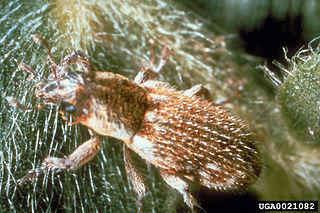 W
WMicrolarinus lareynii is a weevil of the family Curculionidae. It is native to interior regions of Italy, France and Rajasthan in India.
 W
WRhinocyllus conicus is a species of true weevil. It is best known as a controversial agent of biological pest control which has been used against noxious thistles in the genera Carduus, Cirsium, Onopordum, and Silybum.
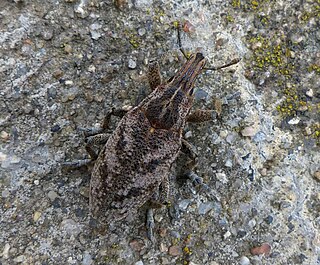 W
WThe sluggish weevil or large thistle weevil, Cleonis pigra, is a weevil species recorded in Britain and native to Eurasia. It was introduced into North America to help control creeping thistle. This species develops in the roots of plants on the family Asteraceae.
 W
WLongitarsus jacobaeae is a species of flea beetle known as the tansy ragwort flea beetle. It is used as an agent of biological pest control against the nectar-rich noxious weed known as ragwort.
 W
WThe thistle tortoise beetle is a species of leaf beetle, situated in the subfamily Cassidinae and the genus Cassida.
 W
WTrichilogaster acaciaelongifoliae is a species of Australian chalcid wasps that parasitises, among others, Acacia longifolia, which has become an invasive pest in several countries. T. acaciaelongifoliae has been introduced into South Africa as a generally successful biological control agent of A. longifolia.
 W
WTrichilogaster signiventris, commonly known as the golden wattle bud-galling wasp, is a species of Australian chalcid wasps that parasitises, among others, Acacia pycnantha. It has been introduced into South Africa, where the golden wattle has become an invasive pest.
 W
WTrichosirocalus horridus is a species of true weevils, native to Europe. It is a biological pest control agent that was introduced into the United States in 1974 to control exotic thistles, especially in the Cirsium and Carduus genera.
 W
WTyta luctuosa is a noctuid ("owlet") moth. Its common names include four-spotted moth and field bindweed moth. It is the only member of the genus Tyta, which forms a hitherto monotypic tribe Tytini in the Catocalinae subfamily. The species was first described by Michael Denis and Ignaz Schiffermüller in 1775. The genus was erected by Gustaf Johan Billberg in 1820 and the tribe was described by Herbert Beck in 1996.
 W
WUrophora cardui or the Canada thistle gall fly is a fruit fly which, contrary to its common name, is indigenous to Central Europe from the United Kingdom east to near the Crimea, and from Sweden south to the Mediterranean.
 W
WZygogramma bicolorata, variously referred to as the Parthenium beetle or Mexican beetle, is a species of leaf beetle in the subfamily Chrysomelinae, native to Mexico.